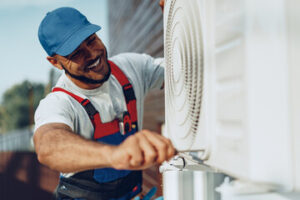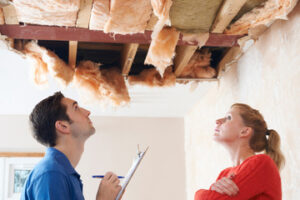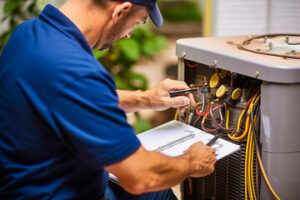A heating, ventilation and air conditioning system is critical for keeping buildings comfortable. This includes residential structures like single-family homes and apartments and commercial buildings.

HVAC Service Naples FL can help you avoid problems and improve the performance and longevity of your equipment. It can also help you reduce energy bills and keep your indoor air healthy.
We often take our HVAC systems for granted, until they stop working in the middle of a winter snowstorm or an industrial plant on a sweltering summer day. This kind of unexpected breakdown can cause significant disruptions to business operations, and can also result in expensive repairs or replacement costs.
To avoid such problems, homeowners should regularly service their HVAC equipment with the help of professional technicians. This can prevent small issues from escalating into major problems that require expensive repair or replacement services. It can also extend the lifespan of an HVAC system.
Getting regular HVAC maintenance is one of the best investments you can make to keep your home or business comfortable. It can also save you money on energy bills and ensure that your system is running efficiently.
While many people think that a professional HVAC service is expensive, the long-term savings can be worth it. Ignoring minor issues like clogged air filters and worn-out belts will eventually lead to extensive damage that requires costly repairs or even a system replacement.
Upgrading to a new HVAC system can visibly increase your home’s value, which makes it more appealing to potential buyers. Additionally, it can reduce your energy bills and improve the air quality in your home or office.
Many people worry that the cost of HVAC repair and maintenance will be too much for them to afford, but savvy consumers can find affordable solutions. A good option is to get a subscription plan that includes regularly scheduled maintenance appointments at a low monthly cost. This can be a great option for both the homeowner and the HVAC service provider, since it provides a steady source of revenue.
While it may be tempting to ignore negative customer reviews, this can have a negative impact on your HVAC company’s reputation and sales. Instead, you can try to understand why the customer is unhappy and resolve their issues. This way, you can avoid bad reviews in the future and provide a better experience for your customers. This can help you attract more customers and build a strong reputation for your company.
Safety
Whether you’re working on your own HVAC system or you need to hire one of the professionals, there are certain safety measures that you should take to ensure your own personal comfort and the health of your home. These basic safety protocols can prevent electrical shocks, fire hazards and leaking carbon monoxide gases.
A thorough inspection by a qualified technician can catch a number of problems that could turn into major issues in the future. For example, a clogged air filter restricts airflow and forces the system to work harder. Similarly, the evaporator and condenser coils accumulate dirt and dust over time, which affects performance. This is why regular cleaning is important. Likewise, the heating system’s burners and valves can become corroded or blocked. Regular maintenance helps to address these issues before they escalate.
Another critical aspect of safety is having the right equipment for the job. This means that technicians should have the proper training and certifications for their specific industry. For example, HVAC technicians need to know how to properly handle gas cylinders and use tools such as wire strippers. They also need to understand the Occupational Safety and Health Administration’s (OSHA) guidelines for their field.
In addition, it’s important for both seasoned and new technicians to be familiar with the specific safety requirements of their jobsites. This includes knowing how to properly lock out circuits, tag equipment that is being worked on and understanding the importance of maintaining a clean workspace. It’s also important for all technicians to wear the appropriate personal protective equipment (PPE) for their field.
In the same vein, it’s a good idea for homeowners to develop a family safety plan that outlines procedures in the event of an emergency. This can include listing the local emergency numbers and establishing a safe meeting spot outside the house. For those that have a gas-powered HVAC system, this is especially critical since a gas leak can lead to poisoning or even deadly carbon monoxide exposure. Developing a safety plan with your family can help everyone stay calm in the event of an emergency and minimize panic.
Efficiency
When evaluating HVAC options, facility managers often focus solely on capital costs without considering operating expenses. However, tracking HVAC key performance indicators (KPIs) can help you optimize your energy consumption and reduce operating costs. There are several different ways to measure the effectiveness of an HVAC system, including simple payback, net savings, savings-to-investment ratio, and adjusted internal rate of return.
Tracking these KPIs can help you identify and address issues that contribute to higher utility bills and decreased equipment longevity. For example, air ducts can become clogged with dust and other debris over time. This can lead to inefficient operation, poor indoor air quality (IAQ), and higher energy bills. Regularly cleaning your air ducts can keep them clear and improve the efficiency of your HVAC system.
A more efficient HVAC system also uses less power, which can lower energy bills and reduce your carbon footprint. It can also help you save on maintenance costs and extend the life of your equipment.
Energy efficiency measures can also increase your home or business’s resale value. Modern homeowners are increasingly interested in energy-efficient features and are willing to pay a premium for them. In addition, upgrading your HVAC system can help you qualify for tax credits and other rebates.
In addition to improving energy efficiency, implementing HVAC maintenance is the best way to ensure long-term comfort and system longevity. Regularly scheduled maintenance can prevent small problems from escalating and can help you avoid costly repairs.
For example, a routine preventative maintenance visit can include air duct cleaning and sealing, air filter replacement, and programmable thermostat setup. It can also include listening for unusual sounds and addressing them promptly to avoid larger issues. This proactive approach will extend the lifespan of your HVAC system and improve its energy efficiency.
Longevity
In addition to reducing energy consumption and costs, regular HVAC service can extend the lifespan of equipment. The longevity measures that HVAC professionals take include cleaning and lubricating parts, identifying early problems, and maintaining proper airflow. These actions help the system operate smoothly and efficiently, reducing the strain on components.
Commercial HVAC systems represent significant investments for property owners, so they must be well-maintained to maximize their lifespan. In fact, studies show that commercial HVAC systems can last up to 25 years with consistent upkeep. However, a lack of maintenance can reduce this lifespan to 15 to 18 years.
The main reason why maintenance is so important is that it catches small issues before they become larger, saving money over time. For example, a $200 airflow check can prevent a $5,000 blower motor repair or a $500 refrigerant top-off can save a $10,000 compressor replacement. Consistent upkeep can also reduce the risk of unexpected breakdowns and lower productivity, which can cause financial losses.
Moreover, maintaining the performance of an HVAC system can increase its resale value. In the real estate industry, a documented history of professional maintenance can lead to higher resale values and faster sales.
Aside from increasing the value of a home, consistent maintenance can lower utility expenses and extend the lifespan of equipment. For example, upgrading to high-efficiency filters can improve indoor air quality and reduce the strain on HVAC components. Similarly, smart thermostats can optimize energy use by ensuring that the system is running at peak efficiency at all times.
HVAC depreciation is a crucial topic for property owners, and understanding it can help them manage their cash flow and optimize tax benefits. There are several methods for measuring the lifecycle cost of a HVAC system, including simple payback, net savings, savings-to-investment ratio (SIR), and adjusted internal rate of return (IRR).
The depreciation of an HVAC system depends on its age and condition. It is important to understand this process so that you can make an informed decision about which system is the best fit for your needs.


